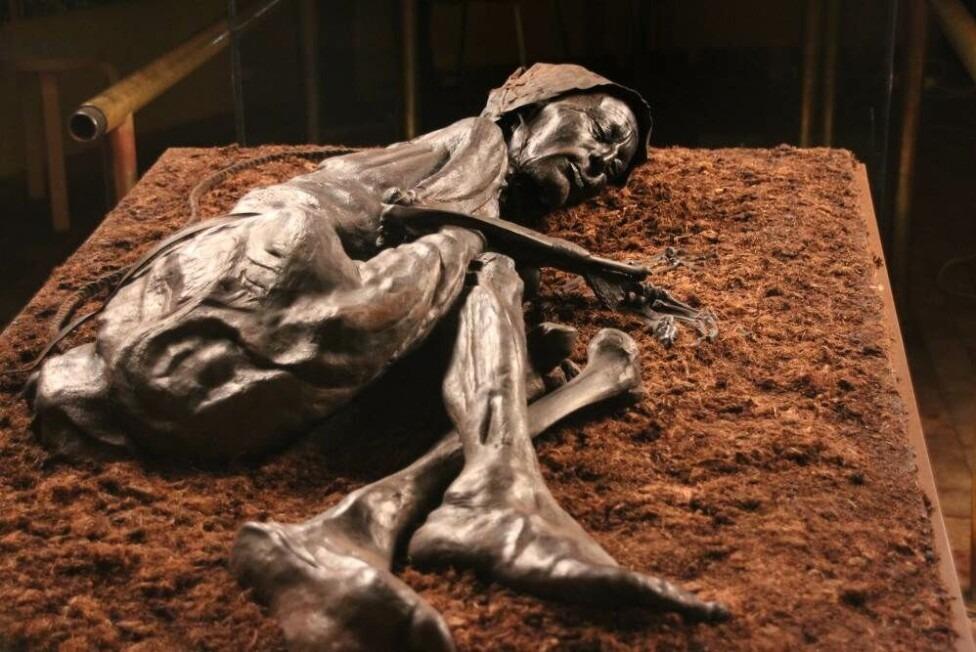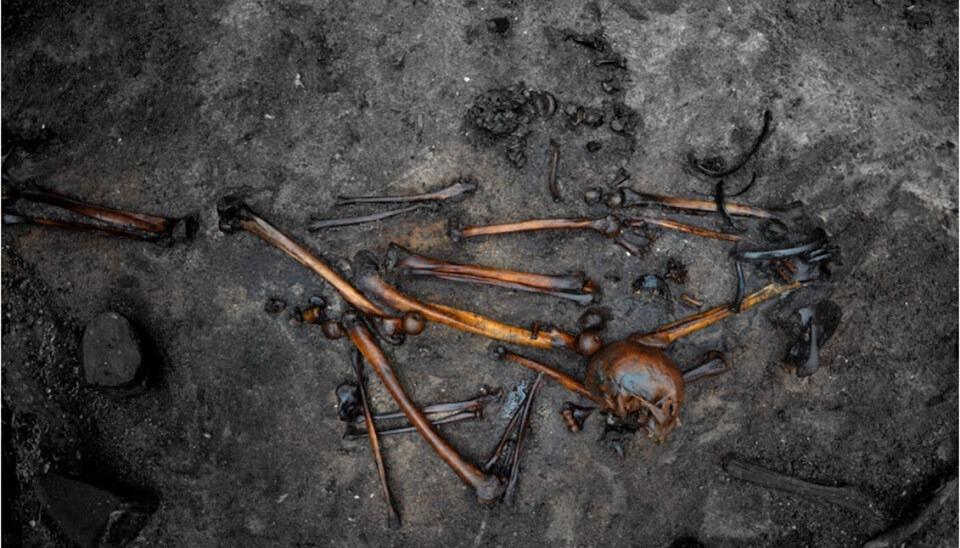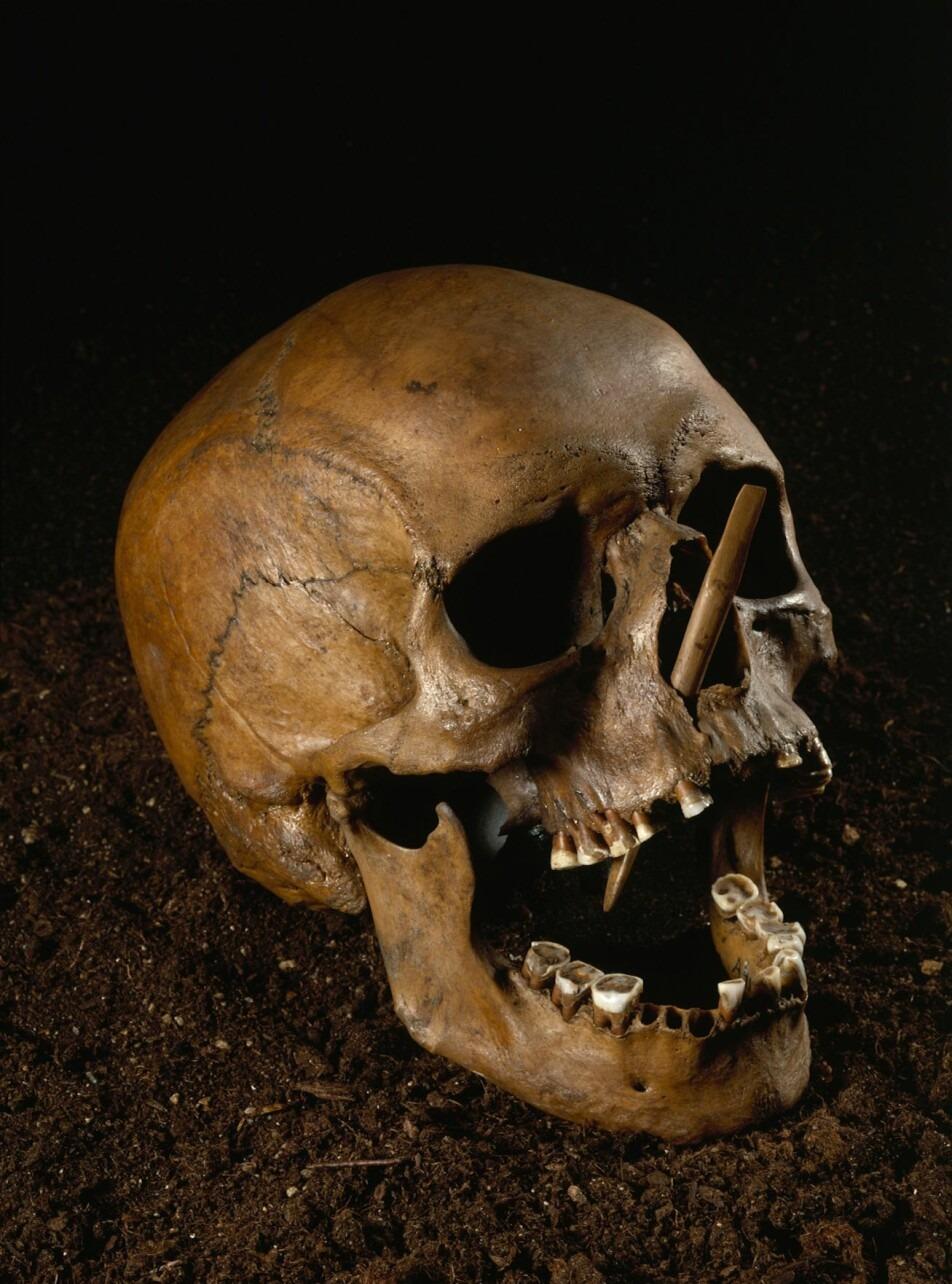Exploring Scandinavia’s Mysteries: Investigating Over 1,000 Bodies, Including Famous Peat Mummies

Although he may seem a bit lonely, the Tollund Man is not the only one to have spent thousands of years in a bog. Scientists have now analysed and dated more than 1,000 bodies and skeletons from wetlands. Photo by: Silkeborg Museum
The Tollund Man, the Grauballe Man and the Huldremose Woman are not the only bog bodies that provide us with insights into the past. We have analysed and dated more than 1,000 bog bodies.
You may have seen them. Behind the glass of museums, their ancient bodies terrify and fascinate us at the same time.
The bog bodies literally put a face on our ancestors and bring us a little closer to the ancient past. It makes us realize how prehistoric and historical times were similar to our own and how they were different.
Not only can we see their facial appearance, we can also glimpse what people were wearing, what they ate, and the organic material that surrounded them, material that is not normally preserved.
These individuals could be said to have been “frozen in time,” providing unique information about certain periods.
Bodies in the bogs have even inspired writers and poets, such as Seamus Heaney, who wrote a poem called ‘The Tollund Man’, or the song ‘Now tell us your name’, also about the Tollund Man, by singer-songwriter Lars Lilholt.
This fascination has led to research focusing largely on sensational finds such as the Grauballe or Tollund men, while less well-preserved human remains have received little attention.
In a new study, we attempt to address this limited focus.
In an effort to understand why and when people ended up in bogs and mires, a new large-scale analysis has been carried out of all dated human remains from marsh areas across northern Europe.
Mummies and skeletons
To fully understand the phenomenon, it is necessary to include all available evidence, including the worst preserved human remains.
Peat bodies can be separated into the following two categories:
- Bog mummies, which include almost intact remains such as the Grauballe Man
- Skeletons from bogs, where only bones remain. The level of preservation of human remains (bones only or with skin and hair intact) depends mainly on the type of bog, as well as the climatic conditions and the time of year when the body was placed in the wetland.
The new study included all scientifically dated human remains from Northern Europe.
This means that more than 1,000 dated human remains were analysed. More than 130 of the dated individuals were found in Denmark.
This is only a fraction of all humans found in swamps, as skeletal material found in wetlands cannot be dated with confidence unless radiocarbon dating is used to place them in time.
Much of this material has not yet been studied. We hope that the new study will increase interest in human remains found in wetlands as a research topic.

The map shows all sites that are included in the study. Map: van Beek et al 2023; Peatland distribution based on Tanneberger et al. 2017
90 sites in Denmark
Most human remains from Danish peatlands were found between 1900 and 1950, when peat digging was still common and peat was extracted by hand.
You can imagine the fright some peat diggers felt when they saw a face or a skull on the tip of their shovel!
In Denmark, bog mummies are found mainly in parts of Jutland, but bog skeletons have been found in most Danish areas, and are especially concentrated in Zealand.
The new study included more than 90 Danish peatland sites.
Of the 266 sites in northern Europe in total, in most of them we only found one human being, although there are some with remains of up to four people.
The bloody story of Alken Enge
The Danish site of Alken Enge stands out, with its excavated remains of 380 individuals, making it one of the largest ‘collections’ of peat bog corpses in northern Europe.
This site is witness to a violent conflict that took place at the end of the first millennium BC.
The dead in this conflict were buried together in a humid landscape.
Of the sites with multiple human remains, most reflect a single deposition event.
However, people have returned to some sites multiple times throughout history, as seen at Bodal Mose in Zealand, where we found two bodies from two different ages: one from the Mesolithic period and one from the Neolithic.

Disarticulated skeletal remains of Alken Enge. Photo by: Peter Jensen
Swamps and bones from six eras
We have divided all bodies and bones into six time periods:
- Phase 1: part of the Danish Mesolithic, 9000 BC to 7000 BC
- Phase 2: spanning the period 5200-2800 BC (the Danish Neolithic part)
- Phase 3: 2800 to 1600 BC (roughly the Danish Late Neolithic)
- Phase 4: 1600-1000 BC (part of the Danish Bronze Age)
- Phase 5: 1000 BC to 1100 AD (covering the arts from the Danish Late Bronze Age to the end of the Viking Age)
- Phase 6: 1100 AD to 1900 AD (covering the medieval and post-medieval period)
The Koelbherg male: one of the old ones
The study shows that the earliest evidence of people being deposited in wetlands occurs in the Mesolithic (9000 – 7000 BC), and that all the earliest known examples come from Scandinavia.
An example of this is the Koelbjerg Male in Funen.
The first phase dates from between 9000 and 7000 BC, with only five bodies, all of them from Scandinavia.
From now on, a long period of time will pass without securely dated human remains.
First sites appear in the UK and Ireland
In the Neolithic (5200 BC – 2800 BC), the tradition becomes evident again. This is the second period.
We can see that it continues throughout prehistory and history with some periods with few finds and others with peaks of activity.
During the Neolithic, most finds were made in Denmark and southern Sweden, but the earliest examples from Ireland and the United Kingdom also belong to this phase.
From phase three (2800-1600 BC), most of the dated human remains have been found in south-east England.
There are also Danish examples, such as a bog skeleton found at Salpetermosen, Hillerød.
The Huldremose woman and her famous underwear
In the fourth phase (1600-1000 BC) no clear geographical group can be seen, but it seems to be a common practice in many regions of northern Europe.
The fifth phase (1000 BC-1100 AD) is the “classic” phase of the swamp body.
For example, we find the Huldremose woman, recently famous for her linen underwear and her fur cloak made from the skins of various species.
Our study shows that this period is longer than previously thought.
The earliest dated samples from Poland and the Baltic states are in this phase, while finds appear to be more common in Denmark, northern Germany and the Irish Midlands than in other areas.
The medieval youth
The sixth and final phase dates from the period 1000-1900 AD, where there are few finds in Scandinavia, but a new group emerges in Ireland and the United Kingdom.
The youngest bog body was found in Ireland at Balykean in 1962.
A man was found buried in a coffin. He was a man who committed suicide in the mid-19th century.
He was not allowed to be buried in the cemetery and was instead buried in the swamp. After his discovery in 1962, he was reburied and is no longer preserved today.
The most recently known Danish bog body was found in Fredriksdal, Kragelund and is from medieval times.
This bog body was found in 1898 and has not been preserved, although the tunic the man was wearing survived and dates to around 1200 AD.
The violent fate of most of the bodies in the swamps
Both adult males and females ended up in wetlands, although there are sites, such as Alken Enge, where only males have been identified.

The Porsmose Man dates back to the Stone Age and was found in 1946. The arrow, preserved in the skull, pierces the bridge of the nose and the jaw and attests to a violent death. Photo by: National Museum
The remains in the bogs also include children, such as a seven to eight year old boy who was placed in Tammosegård Mose during the Neolithic.
The cause of death could only be determined with certainty in 57 cases, and in 45 cases it was a violent death.
Violent deaths are found in all phases except the first, when we have no evidence of violent death of the five men.
Further radiocarbon dating of peat bog skeletons will reveal whether this pattern holds.
The earliest evidence of violent death comes from Denmark, where a man was discovered at Porsmose with an arrowhead embedded in his skull and sternum.
Some of the later examples from historical contexts are of people who committed suicide and were buried in a swamp instead of a cemetery, or who froze or drowned under treacherous circumstances.






